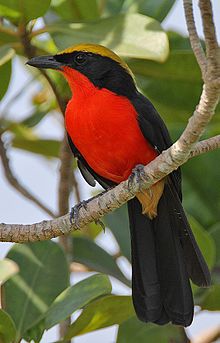| Yellow-crowned gonolek | |
|---|---|

| |
| Conservation status | |
 Least Concern (IUCN 3.1) | |
| Scientific classification | |
| Domain: | Eukaryota |
| Kingdom: | Animalia |
| Phylum: | Chordata |
| Class: | Aves |
| Order: | Passeriformes |
| Family: | Malaconotidae |
| Genus: | Laniarius |
| Species: | L. barbarus |
| Binomial name | |
| Laniarius barbarus (Linnaeus, 1766) | |
| Synonyms | |
|
Lanius barbarus Linnaeus, 1766 | |
The yellow-crowned gonolek (Laniarius barbarus), also known as the common gonolek, is a medium-sized passerine bird in the bushshrike family. It is a common resident breeding bird in equatorial Africa from Senegal and Democratic Republic of Congo east to Ethiopia. It is a skulking bird and frequents dense undergrowth in forests and other wooded habitats. The nest is a cup structure in a bush or tree in which two eggs are laid.
Taxonomy
In 1760 the French zoologist Mathurin Jacques Brisson included a description of the yellow-crowned gonolek in his Ornithologie based on a specimen collected in Senegal. He used the French name La pie-griesche rouge du Sénégal and the Latin Lanius Senegalensis ruber. Although Brisson coined Latin names, these do not conform to the binomial system and are not recognised by the International Commission on Zoological Nomenclature. When in 1766 the Swedish naturalist Carl Linnaeus updated his Systema Naturae for the twelfth edition, he added 240 species that had been previously described by Brisson. One of these was the yellow-crowned gonolek. Linnaeus included a brief description, coined the binomial name Lanius barbarus and cited Brisson's work. The species is now placed in the genus Laniarius that was introduced by the French ornithologist Louis Pierre Vieillot in 1816. Two subspecies are recognised.
Description
The yellow-crowned gonolek is 22 cm (8.7 in) long with a long tail and short wings. The adult is a vividly-coloured bird, although easily overlooked as it lurks in undergrowth. It has solidly black upper parts apart from its golden crown, and scarlet underparts other than a buff-yellow undertail. The legs are dark. Sexes are similar, but juveniles are paler and duller.
Ecology
This species is seldom seen because it inhabits thick undergrowth from which its calls can be heard. These include whistles and rattles, often sung in duet, with a fluted too-lioo overlapped by a rattling ch-chacha. The yellow-crowned gonolek feeds mainly on insects located in bushes or on the ground. The diet consists mostly of beetles and caterpillars, but birds eggs and nestlings are sometimes taken.
It is monogamous and territorial. Some courtship behaviours have been observed with a pair chasing each other through a bush, leaping from branch to branch and emitting metallic twanging sounds. The deep cup-shaped nest is often flimsy and is built in a bush, from rootlets and tendrils. Two, or occasionally three, greyish-green or bluish-green eggs with dark spots are laid.
References
- BirdLife International (2016). "Laniarius barbarus". IUCN Red List of Threatened Species. 2016: e.T22707575A94130248. doi:10.2305/IUCN.UK.2016-3.RLTS.T22707575A94130248.en. Retrieved 12 November 2021.
- Brisson, Mathurin Jacques (1760). Ornithologie, ou, Méthode contenant la division des oiseaux en ordres, sections, genres, especes & leurs variétés (in French and Latin). Vol. 2. Paris: Jean-Baptiste Bauche. pp. 185–187, Plate 17 fig 2. The two stars (**) at the start of the section indicates that Brisson based his description on the examination of a specimen.
- ^ Allen, J.A. (1910). "Collation of Brisson's genera of birds with those of Linnaeus". Bulletin of the American Museum of Natural History. 28: 317–335. hdl:2246/678.
- Linnaeus, Carl (1766). Systema naturae : per regna tria natura, secundum classes, ordines, genera, species, cum characteribus, differentiis, synonymis, locis (in Latin). Vol. 1, Part 1 (12th ed.). Holmiae (Stockholm): Laurentii Salvii. p. 137.
- Vieillot, Louis Pierre (1816). Analyse d'une Nouvelle Ornithologie Élémentaire (in French). Paris: Deterville/self. p. 41.
- Gill, Frank; Donsker, David, eds. (2018). "Batises, woodshrikes, bushshrikes, vangas". World Bird List Version 8.1. International Ornithologists' Union. Retrieved 21 June 2018.
- ^ Harris, Tony (2010). Shrikes and Bush-shrikes: Including Wood-shrikes, Helmet-shrikes, Shrike Flycatchers, Philentomas, Batises and Wattle-eyes. Bloomsbury Publishing. pp. 248–249. ISBN 978-1-4081-3459-7.
- Birds of The Gambia by Barlow, Wacher and Disley, ISBN 1-873403-32-1